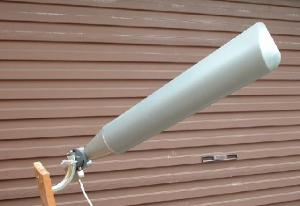Pulsat LX2000 Satellite Antenna - A Comparison with Other Satellite Antennas December, 2003
|
Introduction
The Pulsat LX2000 is an unusual design of antenna for reception of DTH (direct to
home) satellite signals. It includes a single-output LNB (Low Noise Block)
covering both low-band and high-band and horizontally and vertically polarized
transmission modes. It is intended to have lower visual impact than a
conventional dish antenna and can be mounted behind plastic materials for even
better concealment.
Intended applications include population areas where satellite dishes, or
multiple satellite dishes, are not allowed. Living in an area known as a
‘Conservation Area', steeped in history going back to Queen Elizabeth 1st
time, such an antenna is of great interest to me. I have always found
satellite dishes to be unsightly, so this mellow green-grey piece of pipe
seemed well worth investigating.
Mode of Operation
The LX2000's performance
can be measured, and the rest of the article covers this in some depth.
However, the design principles upon which it works can only be surmised. As an
engineer with some familiarity with audio techniques, the nearest I can come
to deducing how it works is by comparison with a ‘rifle microphone' (shotgun mic). A rifle mic is directional in the same way that a satellite antenna needs to be. Both
design concepts need gain also. In the case of the rifle mic, delay is
introduced along the length of the tube such that signals from the required
direction all arrive in-phase and so add together, giving the gain. In the
case of the LX2000, I would guess that the tube contains dielectric material
which only passes-on the frequencies required, in the direction required. By
carefully designing the delay along the length of the tube, signals from the
wrong direction should cancel out and those from the required direction add
together. But that's just a guess, and I'm not about to dismantle 200 bucks
worth of kit to find out!
Choice of Receivers and Transmission
The selection of receivers I use for satellite reception is shown in the
figure below. From top to bottom, they are the Amstrad-Fidelity SRX200, the Sakura
SR800ER, the Pace Prima, and the Nokia SAT780. I find the SRX200 easiest to
retune for experimental purposes such as this – the others are better in a
fixed domestic situation where remote control and greater program memory are
more important. The SRX200 also has a built-in frequency display rather than a
channel number, and this aids repeatability during the tests. The frequency
recorded differs from LNB to LNB due to internal offsets, so my results tables
include the frequencies noted for the transmissions selected.
Dozens of different frequencies are in use on the strongest available
satellite, Astra. I chose stations near the bottom, the middle, and the top of
the frequency range, these being:
CNBC Europe on 10729 Vertical, a program of news and current affairs
Viva on 11127 Vertical, a mixture of pop and youth culture programming, and
MTV-2 Pop on 11421 Horizontal – pop music with an ‘edge'.
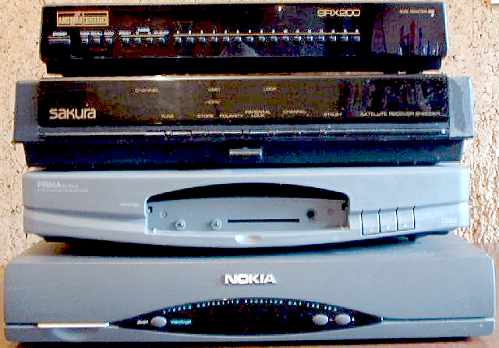
Evaluation Procedure
Three different antennas were used: the LX2000 under test, a Sky MiniDish ™
and a full-size (2 foot) standard DTH dish. Each has its own LNB (described
later), and each was set up to give maximum reception. For the strongest
signal, the direction and elevation need to be correct, and the amount of
‘twist' with respect to horizontal needs to be correct as well.
MiniDish
The MiniDish is about 40 cm across. It is fitted with a Grundig LNB, complete with built-in twist adjustment. Adjustment for maximum signal was straightforward – just setting the receiver to one of its preset channels and waving the dish around in the approximately right direction gives a TV image that can quickly be homed-in on. From the maximum signal direction, the strength trails off significantly when the LNB is displaced more than about one inch from the optimum setting.
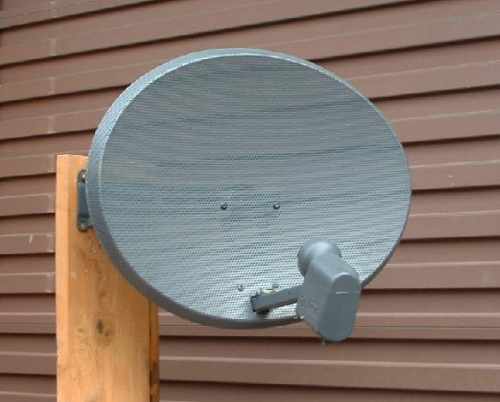
From the table below, it is clear that, in my location in South-East England,
a MiniDish is only suitable for signals towards the upper end of the
frequency band. This is entirely respectable performance since the dish is
intended for use with SkyDigital ™ transmissions from a different satellite
cluster.
LX2000 Tube Antenna
As mentioned, the LX2000 has its own LNB already fixed to it, but the model of LNB is not shown on the casing.
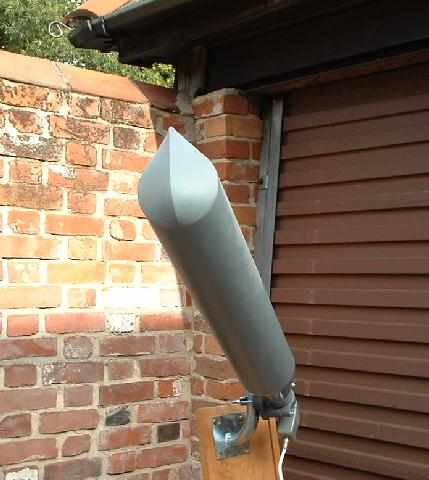
Finding the satellite is just as easy as with the MiniDish. In fact, the
LX2000 is far less directional than conventional dish antennas. This is a
mixed blessing: it certainly eases initial setup, but may leave the device
more prone to unwanted signals. I would say that the tip of the antenna can
easily move 4 inches before the signal deteriorates significantly. Of course,
this helps when there is a lot of wind about, since the tube could deflect a
certain amount due to wind loading.
The table shows overall results rather worse than with the MiniDish, its chief
competitor. Significantly, there is a suck-out in the central frequency band
which could indicate that the dielectric material I suggest is within the tube
may not be fully balanced for frequency-response across the whole range.
|
Station Name |
Frequency |
Results |
|
CNBC Europe |
0978 |
Excessive sparkles |
|
Viva |
1376 |
Unwatchable – too weak |
|
MTV-2 |
1664 |
Near perfect, very slight sparkles |
Standard 2-foot dish
I have both perforated dishes (as illustrated) and solid-back dishes available for my normal satellite reception. The dish used for the tests has a BZT brand LNB fitted, and results are perfect. For a weaker satellite (e.g., Hot-Bird), it is likely that the solid-back dish would perform better, but that is not the purpose of these tests.
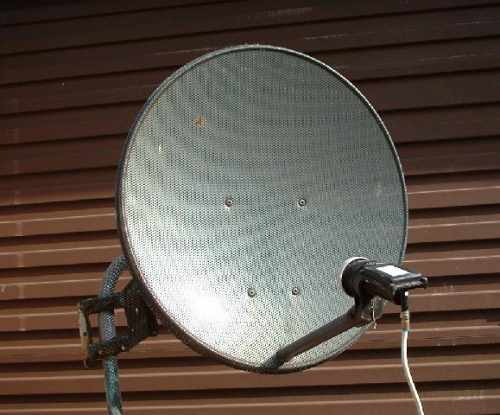
|
Station Name |
Frequency |
Results |
|
CNBC Europe |
0980 |
Excellent |
|
Viva |
1377 |
Excellent |
|
MTV-2 |
1664 |
Excellent |
Mechanical
For all the tests, a Work-mate workbench held the antennas. Elevation
adjustments were made using the crude but quick and highly effective use of a
car-jack under one corner of the workbench.
The LX2000 has some mechanical issues of its own. The swivel mount supplied
has too many interdependent adjustments. Just slacken off the fixing screws
and you can swivel the twist of the unit, slide it up and down the pole and
move its direction around. Trying to balance all of these while fixing it to a
chimney stack must be a nightmare.
The tubular cover is held on by gaffa tape (duct-tape, Elephant-brand tape).
As a devotee of gaffa tape, I won't criticize this other than to say that
several years of weathering might weaken the tenacity of even the finest gaffa.
However, I do take issue with using gaffa tape to hold the LNB to the
cast-alloy body of the LX2000. The two illustrations are intended to show how
the tape flexes with even a moderate amount of pressure from me (those are my
hands in the picture). I noticed this flexing when I first connected a coaxial
cable to the unit, so I enquired of the suppliers, Pulsat, whether I could use
additional gaffa tape to beef-up this arrangement. They said they didn't mind
and this will certainly be used before mounting on a high point of the house.
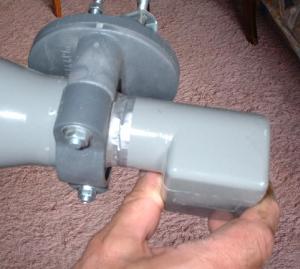
Conclusions
Reception strength using the LX2000 is likely to be marginal in most UK
locations. It seems to have a lower sensitivity than the MiniDish, so reception
of SkyDigital transmissions is likely to be more affected by rain-fade and to
not be possible in more northern areas of the UK and the rest of Europe.
As an addition to my stock of test antennas, the LX2000 tube antenna is very
welcome and may find a home on the chimney stack as receiver technology moves
on.
- Graham Vine -
|
© Copyright 2003 Secrets of Home Theater & High Fidelity |
![]()

